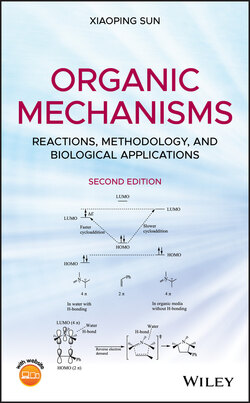Читать книгу Organic Mechanisms - Xiaoping Sun - Страница 28
1.7 ELECTRONIC EFFECTS AND HAMMETT EQUATION 1.7.1 Electronic Effects of Substituents
ОглавлениеSubstituents on aromatic (phenyl) rings can increase or decrease the electron density in the ring by donating or withdrawing electrons. This alters rates and/or equilibrium constants for the reactions occurring in the ring and in the side group attached to the ring. Such electronic effects of substituents can be quantitatively defined on the basis of their influence on the acidity (dissociation constant) of para‐ or meta‐substituted benzoic acid (XC6H4COOH) relative to benzoic acid (C6H5COOH) (Eq. 1.56):
(1.56)
In Equation 1.56, KA and KH are the acid dissociation constants of XC6H4COOH and C6H5COOH, respectively. lg is the common logarithm (10‐based logarithm). The σ value defined in the equation is called Hammett substituent constant for a given substituent –X at para‐ or meta‐position. The para‐ or meta‐substituted benzoic acids (XC6H4COOH) with different –X groups are in general commercially available or easy to synthesize. The pKA (–lgKA) value for each XC6H4COOH is numerically equal to pH of a solution containing equalmolar concentrations of the acid and the sodium salt of the conjugate base and can be readily determined experimentally. Therefore, the σ constants for various substituents can be obtained readily [1].
The electron‐donating and electron‐withdrawing effects of various substituents originate from combination of inductive and conjugation effects. In general, an electron‐withdrawing group (EWG) on the phenyl ring of XC6H4COO−, such as –NO2 (nitro), –C(O)R (acyl), –SO3H (sulfonic acid), and –CN (cyanide), lowers the electron density in the ring facilitating delocalization of the negative charge of the carboxylate to the ring. This stabilizes the XC6H4COO− anion, resulting in an increase in KA relative to KH. Therefore, the σ constants for EWGs are usually positive (σ > 0 for EWGs). On the other hand, an electron‐donating group (EDG) on the phenyl ring of XC6H4COO−, such as –R (alkyl), –OH (hydroxyl), –OR (alkoxy), and –NH2 (amino), enhances the electron density in the ring to disfavor the delocalization of the negative charge of the carboxylate. This destabilizes the XC6H4COO− anion, giving rise to decrease in KA relative to KH. Therefore, the σ constants for EDGs are usually negative (σ < 0 for EDGs). The substituents on the ortho‐position of the phenyl rings often produce steric hindrance on the side group next to them. Therefore, the electronic effects of the ortho‐substituents are usually not considered.
For a given substituent (EWG or EDG), the extent of its electronic effects on the side group (–COO−) of XC6H4COO− is different when the substituent is placed on the para‐position and on the meta‐position. Therefore, the σ constants for the substituent on para‐position (σpara) and on meta‐position (σmeta) are different. For example, the electron withdrawing effects of –NO2 on both its para‐ and meta‐carbons are mainly due to its conjugation effect. The conjugation effect of a para–NO2 to the side group –COO− is stronger than a meta–NO2. Therefore, the σpara (0.81) is greater than the σmeta (0.71) for –NO2 (σ > 0 for EWGs) [1]. This is also true for some other EWGs (–CN, –CF3, and –CO2Me) whose major electronic effects on both their para‐ and meta‐carbons are conjugation effects, and we have σpara = 0.70 and σmeta = 0.62 for –CN; σpara = 0.53 and σmeta = 0.46 for –CF3; and σpara = 0.44 and σmeta = 0.35 for –CO2Me [1]. For EDGs whose major electronic effects are conjugation effects, the absolute value of σpara is greater than the absolute vale of σmeta (σ < 0 for EDGs). For example, we have σpara = –0.14 and σmeta = –0.06 for –CH3; and σpara = –0.32 and σmeta = –0.10 for –N(CH3)2 [1].
